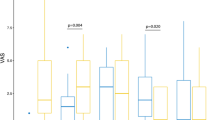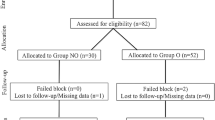Abstract
Purpose
Minilaparotomic access in spinal anaesthesia represents an example of mininvasive surgery and could be a valid cost–benefit alternative in the surgical treatment of benign gynaecologic diseases.
Methods
The study is a randomized study. We analyzed a consecutive series of 80 patients treated for benign gynaecological diseases with spinal (group A) or with general anaesthesia (group B).
Results
The median length of incision was 5 cm. The average operating time was 40.5 ± 9.39 min, without differences between groups. The average hospital stay was 0.71 days shorter (p ≤ 0.0001) and the postoperative pain was lower at 2 and 6 h from the surgery and at 10 p.m. in the group A (p ≤ 0.0001).
Conclusions
Minilaparotomy in spinal anaesthesia carries advantages from economic point of view with reduction of length of stay in hospital which is an important parameter for the evaluation of the quality of surgical treatments.


Similar content being viewed by others
References
Panici P, Zullo MA, Angioli R, Muzii L (2005) Minilaparotomy hysterectomy: a valid option for the treatment of benign uterine pathologies. Eur J Obstet Gynecol Reprod 119(2):228–231. doi:10.1016/j.ejogrb.2004.07.039
Fanfani F, Fagotti A, Longo R, Marana E, Mancuso S, Scambia G (2005) Minilaparotomy in the management of benign gynecologic disease. Eur J Obstet Gynecol Reprod 119(2):232–236. doi:10.1016/j.ejogrb.2004.07.040
Flynn MK, Niloff CM (1999) Outpatient minilaparotomy for ovarian cysts. J Reprod Med 44:399–404
Cagnacci A, Pirillo D, Malmusi S, Arangino S, Alessandrini C, Volpe A (2003) Early outcome of myomectomy by laparotomy, minilaparotomy and laparoscopically assisted minilaparotomy. A randomized study. Hum Reprod 18(12):2590–2594. doi:10.1093/humrep/deg478
Muzii L, Basile S, Zupi E, Marconi D, Zullo MA, Manci N, Bellati F, Angioli R, Benedetti Panici P (2007) Laparoscopic-assisted vaginal hysterectomy versus minilaparotomy hysterectomy: a prospective, randomized, multicenter study. J Minim Invasive Gynecol 14(5):610–615. doi:10.1016/j.jmig.2007.05.012
Alcalde JL, Guiloff E, Ricci P, Solà V, Pardo J (2007) Minilaparotomy hysterectomy assisted by self-retaining elastic abdominal retractor. J Minim Invasive Gynecol 14(1):108–112. doi:10.1016/j.jmig.2006.06.030
Fanfani F, Fagotti A, Ercoli A, Bifulco G, Longo R, Mancuso S, Scambia G (2004) A prospective randomized study of laparoscopy and minilaparotomy in the management of benign adnexal masses. Hum Reprod 19(10):2367–2371. doi:10.1093/humrep/deh413
Fanfani F, Fagotti A, Bifulco G, Ercoli A, Malzoni M, Scambia G (2005) A prospective study of laparoscopy versus minilaparotomy in the treatment of uterine myomas. J Minim Invasive Gynecol 12(6):470–474. doi:10.1016/j.jmig.2005.07.002
Glasser MH (2005) Minilaparotomy myomectomy: a minimally invasive alternative for the large fibroid uterus. J Minim Invasive Gynecol 12(3):275–283. doi:10.1016/j.jmig.2005.03.009
Palomba S, Zupi E, Falbo A, Russo T, Marconi D, Tolino A, Manguso F, Mattei A, Zullo F (2007) A multicenter randomized, controlled study comparing laparoscopic versus minilaparotomic myomectomy: reproductive outcomes. Fertil Steril 88(4):933–941. doi:10.1016/j.fertnstert.2006.12.047
Benedetti-Panici P, Maneschi F, Cutillo G, Scambia G et al (1996) Surgery by minilaparotomy in benign gynecologic disease. Obstet Gynecol 87:456–459. doi:10.1016/0029-7844(95)00441-6
Benedetti-Panici P, Zullo MA, Casalino B, Angioli R, Muzii L (2003) Subcutaneous drainage versus no drainage after minilaparotomy in gynecologic conditions: a randomized study. Am J Obstet Gynecol 188:71–75. doi:10.1067/mob.2003.103
Hoffman MS, Lynch CM (1999) Minilaparotomy hysterectomy. Am J Obstet Gynecol 181(4):1037–1038. doi:10.1016/S0002-9378(99)70349-2
Bird SB, Dickson EW (2001) Clinically significant changes in pain along the visual analogy scale. Ann Emerg Med 38(6):639–643. doi:10.1067/mem.2001.118012
Gracely RG, Dubner R (1987) Reliability and validity of verbal descriptor scales of painfulness. Pain 29:175–185. doi:10.1016/0304-3959(87)91034-7
Dixon JS (1986) Agreement between horizontal and vertical visual analogue scales. Br J Rheumatol 24:415–416
Price DD, McGrath PA, Rafii A, Buckingham B (1983) The validation of visual analogy scales as ratio scale measures for chronic and experimental pain. Pain 17:45–56. doi:10.1016/0304-3959(83)90126-4
Ferraris G (1986) Tecnica chirurgica. Chirurgia Ginecologica e Ostetrica. Utet
Conflict of interest statement
None.
Author information
Authors and Affiliations
Corresponding author
Rights and permissions
About this article
Cite this article
Surico, D., Mencaglia, L., Riboni, F. et al. Minilaparotomy in spinal anaesthesia: a surgical choice in treatment of benign gynaecologic disease. Arch Gynecol Obstet 281, 461–465 (2010). https://doi.org/10.1007/s00404-009-1113-1
Received:
Accepted:
Published:
Issue Date:
DOI: https://doi.org/10.1007/s00404-009-1113-1




